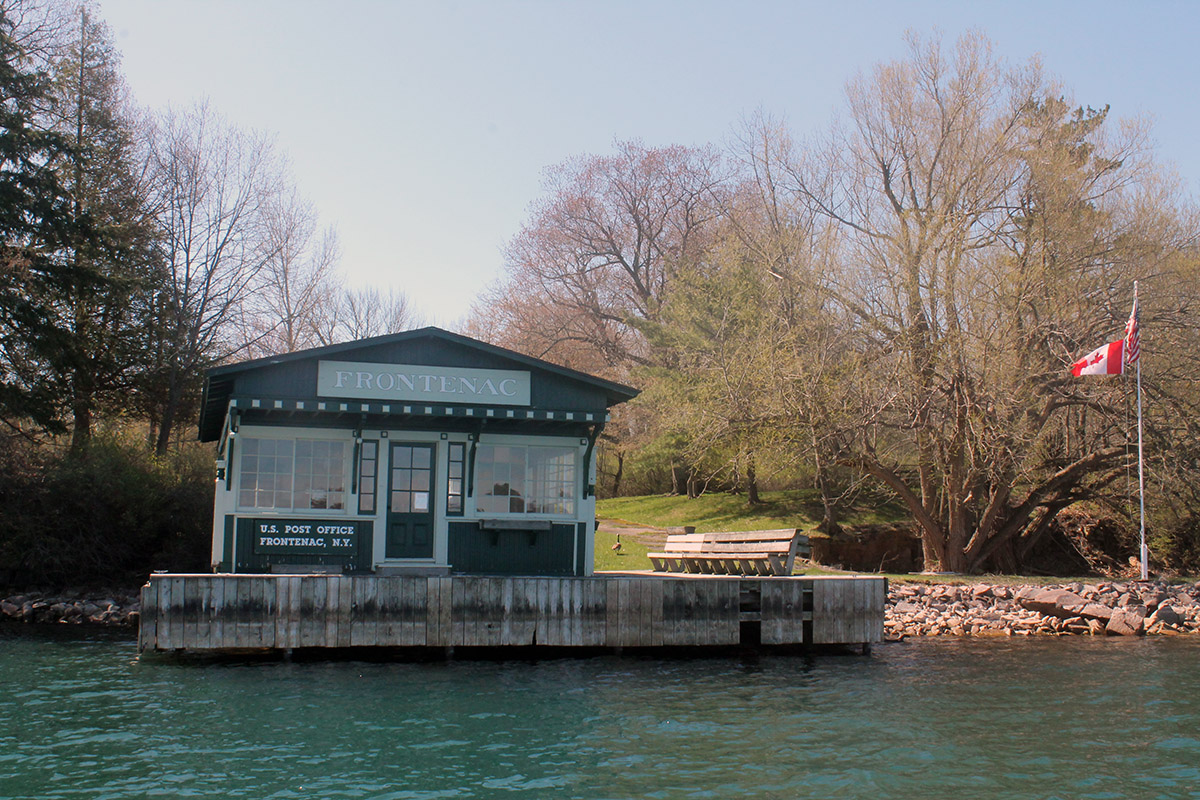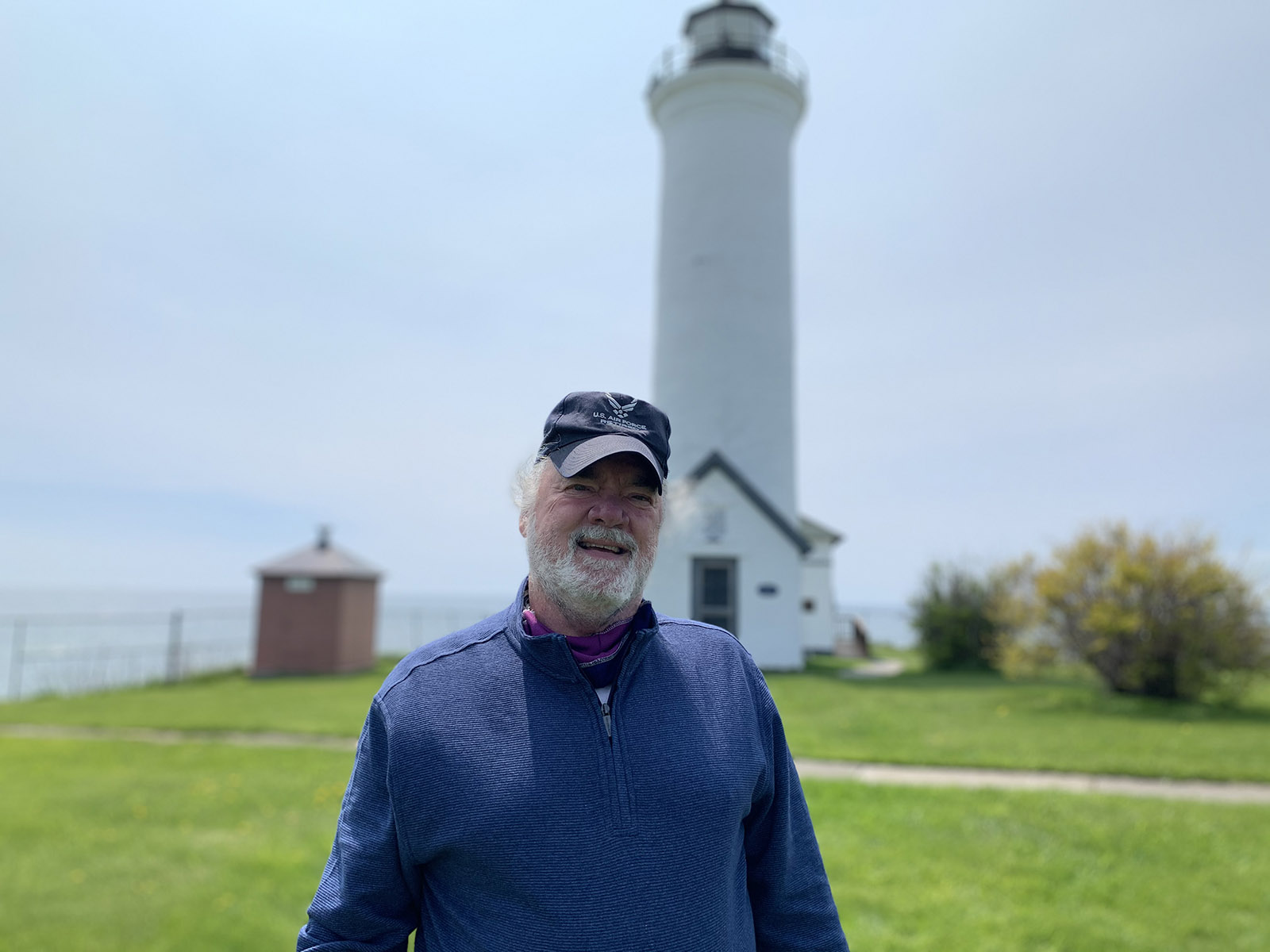The slip was quiet and empty with river boats still moored at daybreak. The waters of French Bay Marina in Clayton, N.Y. remained undisturbed, and each keel stayed in its place as the early sun overhead lit up the storage. Rows of discolored skiffs hung from straps above and beside me. At the end an old Lyman waited, its sides polished wood, its frame narrow, and upholstery a clean, deep maroon. As I lowered myself onto the sleek deck of the antique craft, my legs gave way to the rhythm of the current. The boat rocked from stem to stern but then settled as it floated off. Along with my guide for today’s early morning outing, Jeff Garnsey, we left a quarter to ten, and a mile out from the landing we realized the whole river belonged to us. No barges, ferries, or yachts. I watched as an outflow stirred sandy loam up from the river bottom, filling the inlet with a murky, brown plume. Looking ahead, I saw an endless stretch of midnight blue water with too many islands around to count.
After a year spent landlocked and inside, it was time to push out. I set off to the Thousand Islands for distraction and repair from the realities of a college senior staring down life (not to mention the sleepless nights, chronic migraines, and everyday façade of not showing feeling or complaining). The natural thing to do with unsurfaced desperations is find some good old-fashioned escapism. I had neglected my mental health for long enough. Take me to the river, I thought.
To get there, I had to drive about 90 miles. A live rendition of “You Might Die Trying” by the Dave Matthews Band crackled in and out of my cheap Bluetooth stereo — not that I listened. I felt numb. The inside part of my head ached, a parting gift from the after-hours of final projects and assignments. If I followed the highway, I thought, I could get far enough away and leave it all behind. Somewhere, close, was the escape I longed for. As I drove, my eyes adjusted to the light, and I made out the ramshackle cottages, humble motels, and faded billboards off to the side of the road that signaled my destination was close. It was preseason, before the mad rush. Things seemed desolate now but come Memorial Day, flip-flopped, sunscreen-covered tourists would clog these streets. I wanted to beat them to it. The motels and boat supply stores that passed in the mirror possessed a charming ruggedness and looked like the kind of spaces held together by the efforts of generations of kinfolk. This was not a new up-and-coming place. And the people who live here work to preserve that.
Upstate New York offers, for the most part, scattered lakes or canals. But just within reach sits the Thousand Islands of the St. Lawrence River, an unevenly distributed, sparsely populated archipelago through which about 23% of the planet's freshwater runs (and about 90% of that water travels over Niagara Falls). But more than the water drew me here. This area boasts generations of individuals bound by history and a geography that connects them just like the islands that give this place its name.
People like Garnsey, a local, third-generation captain. “That’s old boat smell,” he says to me when I ask about the sharp, paint-thinner-esque fumes that interrupted my thoughts and seared the insides of my nostrils. He tells me wooden boats — such as the one we’re aboard — possess a smell that is unique to them, like an old fuel or gas burn. Garnsey, a retired master chief in the U.S. Navy, knows boats, and he left his position in the Navy to return to this area and become a purposeful caretaker of traditions on the St. Lawrence River. Although the Garnseys have been here for seven generations since 1823, and all of them have been riverboat people, they’ve been river captains for less than half of that time. His son will be the fourth consecutive captain in line when he retires from the Navy in five years. “That's why it's important to me not to mess up tradition because it's going to be his too, to tell the stories, the everything about the river,” Garnsey says. “When you start snipping corners and making things, you know, a little flowery or changing them, then you lose that.”
The elusive that Garnsey references brought me here. I felt a metaphysical pull to get out on the water, as if I was meant to dip in and wipe my slate clean. Something that might lower my heart rate and stress levels. But despite the glint of the sun on the water, the chilly air ripped through layers of my clothes, and I wondered if I jumped the gun on my visit. Most of the nearby establishments remained closed, and last week a thin blanket of snow covered the ground. The speed of the boat and brisk current amplified the cold. My feet were frozen. I couldn’t move my toes. For the first cruise of this season, middle-aged Garnsey sported a tan, insulated coverall over a sweatshirt plus a Navy cap. The shine of the water reflected in his aviator sunglasses as he scanned the path ahead. Not that he needed direction. He pointed out each summer home we passed, sharing details about the property, the history, even the people who owned it.
As we curved around what he called Round Island, he pointed out the place where he prepares traditional shore dinners for those who charter his boat: fat-back sandwiches, fish (cleaned on site), corn on the cob, salt potatoes, tossed salad, and then Canadian French toast for dessert, which he makes over a granite fire pit on the shore. A friend of his owns the head of the island and built the dinner ground for him without ever taking a dime.
A massive Victorian estate emerged on the port side, and off the starboard bow a small green building in need of a paint job appeared. Garnsey continued to narrate, telling me that green building is the oldest continuously operating river post office in North America, and that he knows the mailman. “He delivers from Memorial Day to Labor Day, Monday through Saturday to the Frontenac post office,” Garnsey says. “That post office and the only reason that it's continued to survive is because every member of the association has one trained postmaster in the family. And none of them take pay. They all do it free of charge.” I gazed into the water and saw the foundations of a pier now gone. The chop was slight, and the hull was steady. The engine produced a gentle hum as we pressed on.
Each river community here formed its own identity over time, from the people who live there year-round. Garnsey believes notable differences exist between them. “Think of Clayton, Cape Vincent, and Alexandria Bay in terms of Goldilocks and the Three Bears,” he says. “You have, remember the porridge — one of them was too hot, one of them was too cold, and one of them was just right.” A lifelong Clayton native, Garnsey witnessed how the village adopted ideas of people who weren’t necessarily from there but came, planted their flag, brought money, and tried to include other people. This made it a hub for nonprofits and independent, family-owned businesses. Alexandria Bay, however, exists as a hospitality town by design. Anchored by popular attractions such as Uncle Sam Boat Tours, Boldt Castle, and Singer Castle, tourism fuels trade all summer long but slows down in the wintertime. Cape Vincent, meanwhile, is its own farming enclave and far more private, out of the way for visitors who lack roots to the community.
But Laurie Marr, St. Lawrence County resident and Director of Public Affairs for the Development Authority for the North Country, thinks that there’s synergy among them. Marr has seen each community plan their summer events around one another to avoid competition for attracting visitors. Also, when there’s a larger event in a smaller community, then the others benefit from putting guests up in hotel rooms. “It’s always been an unspoken rule that they don’t step on each others’ toes,” she says.

The Frontenac post office remains up and running on account of generations of trained river postmasters from the St. Lawrence River area. Photo by Michael Garcia.
These towns also face the same challenges. For decades, tourism built seasonal businesses, and that truth persists. Without their main economic driver in the off seasons, almost everything closes down. Marr says many residents that work at the restaurants, shops, and bars go on unemployment in the wintertime. Although some would rather create their own way. “I’ve noticed especially over the last 20 years, people have started their own island or property services businesses where they offer to be caretakers of the property,” she says. They operate like security guards for the property, Marr explains, checking to make sure there’s no flooding or damage when the seasonal people are away.
In spite of all this, there remains a constant presence here. A beloved, compelling, and mythological subset — the River Rat. The criteria for this label of honor seemed to be full-time dedication to living along the water, then transferring that lifestyle to the next generation. And yet residents of the islands also operate like the islands, distinctly separate but somehow connected. Therefore, I heard various interpretations of who can adopt the term River Rat for themselves and a range of qualifying characteristics. “It’s kids who grow up tying a life jacket on the handlebars of their bicycle and zooming the bicycle down between the buildings on the waterfront, flying off into the water with the lifejacket on the bicycle not on themselves,” Marr says.
Susan Smith, writer and editor of Thousand Islands Life Magazine, says some people think it means you have to be born and raised on the river, but she offers her own definition. “I believe that a River Rat is somebody who's here through the good and the bad and, you know, through the cold weather and the miserable weather, but is always out on that river. You know, in a boat, whether you have to be or not,” she says.
Locals possess a love–hate relationship with the river. But with that comes tolerance.
Based on the many conversations I had about this title, I doubt there's any consensus on who can call themselves a River Rat. Nor do I think its origins trace back to one particular place. But I do know this. Come here and anyone you encounter will tell you what it means to them. But, for me, the title embodies an attitude, an enthusiasm for sharing outdoor joy with others, and here that’s just about everyone.
In fact, that enthusiasm from locals (whether they call themselves River Rats or not) spreads easily to those who, like me, come in search of a simpler, nature-informed existence. Many of these families have been here for generations. More than a few drifted in as tourists, caught the river infatuation shared by those who call it home, and stayed. These are people like Judy Keeler. She arrived in 1972, became addicted to the area, and never left, carving out a life as a school speech therapist. Keeler volunteers at the Cornwall Brothers Store and Museum. Like so many other historical sites in the village, it was closed during my visit. However, when I met Keeler there, she opened both doors, and we entered the building, which possessed a stone-cold chill that rivaled the river boat on open water. Keeler, who wore a long tan coat and peered through glasses, even pulled off the sheets, uncovering a restored skiff, which sank not far from the museum.
As I followed her, even though I stepped carefully, the wood boards creaked and reverberated off the square walls of the box-shaped museum. Thanks to some erosion that undermined one side of the bedrock upon which the building sat, the floor angled and dipped. I’m told that if you place a marble down by the front door it will roll across and into the far corner. Dusty memorabilia sat piled up and roped off. Framed, black-and-white pictures featuring old fishermen poised with their vessels hung on every wall. In fact, Keeler credits these fishing guides from previous generations with turning this remote yet accessible area into a playground for the wealthy. The picturesque islands and the abundance of wildlife attracted aristocratic sportsmen who came for vacations and facilitated enterprise. “When President Ulysses S. Grant came here in August of 1872, there was a lot of publicity and started the Golden Age here,” Keeler says. After that, word spread, and wealthy city-dwellers, intrigued by the natural beauty, arrived on George Pullman railroad cars and built homes. Their arrival then attracted others who, in turn, came for the sightseeing and displays of affluence, including castles, estates, and mansions.
We moved toward the back of the museum, and I could see the grandiose Boldt Castle through a window. “So, you're looking at the very center of what was millionaire's row, with Boldt [Castle] right here.” she says. But the other homes were either torn down or destroyed by fire. At one time the Cornwall Brothers Store was surrounded by prominent hotels. “As many as there were, nobody was really competing with each other because they were all full all the time, we were just so popular,” Keeler says. Prohibition and the Great Depression hit this area hard, draining the area of well-to-do patrons and the events and tourists they brought to the region. The museum’s collection of photographs reinforced these stories. They also captured how residents persisted without hotels, patrons, and conventions. I saw photos of packed streetcars and boat races, including images from The Thousand Islands International Marathon, which drew competitors from all over the East Coast and Canada.
Keeler says locals possess a love–hate relationship with the river. But with that comes tolerance. “It used to be in the golden age, that your seasonal people were wealthy and your not seasonal people weren't. And oftentimes, they found their employment working for the seasonal people,” she says. “I taught in the school and the thing was that the kids who lived here year-round, their parents worked all summer. So, when they were on vacation from school, that’s when their parents worked many hours.” To make a living in and on the St. Lawrence demands adaptability, but with that adaptability comes rewards. Everyone seemed to know this. “To me, a River Rat knows where all the rocks are and aren’t,” she says. “One of the first things he [Keeler’s husband] taught me is you go where you know, you never know where they all are, so you know where they all aren't, you pick your path.”
I planned to see the rest of the area’s history, but my empty stomach called for a detour. Luckily, Mike Cougler, president of the Tibbetts Point Lighthouse Historical Society and U.S. Air Force retiree, knew a place. French Towne Market in Cape Vincent looked like a typical small-town grocery store but featured a sub shop toward the back, tucked into its deli. Cougler wore an Air Force cap, with a dark-colored mask that covered his white beard and hair.I stood by him in the dim light, in front of a blood-red selection of meat for my buffalo chicken, mayo, and hot peppers on white. I’m told the bread was baked this morning. I noticed a stale taste in the air, something akin to cold cuts and the past conversations of familiar customers. As we waited for our subs, Cougler tells me that back in the 1920s, dairy farmers and passengers from a train that came to the county filled the area. But as highways got better and trains became more expensive, those tracks and the passengers they delivered were taken out.

Mike Cougler keeps watch over the 58-foot-tall, stone lighthouse at the furthermost point of the river. He not only tends and cares after its equipment but the stories it can tell. Photo by Ben Oleksinski.
Nourishment found, we went on to the lighthouse. Steering our cars around a shoreline road, I noticed out of my passenger-side window how the sky seemed taller, the water deeper blue than before. Massive wind turbines, much to the irritation of residents and farmers, loomed in the periphery. I could make out a barge disappearing into the horizon. It occurred to me that this thin edge formed the outer limits of the U.S. Tibbetts Point, which marks where Lake Ontario and the St. Lawrence River meet at the furthest end of the seaway, the symbolic exit to Canada. The lighthouse at the end of the drive served as our final destination and landing place. And, like a convoy, we proceeded. Neither of us hurried.
When we arrived and began walking toward the point, clouds of gnats surrounded us, making it difficult to take in the view while waving them off. But despite the flailing required to tame the gnat swarm, it failed to ruin the moment. Before us stood a 58-foot-tall, stone lighthouse, accompanied by the keeper’s dwellings, visitor’s center, outhouse, and fog signal house. Not a single cloud or bird. Over the thin, chain-link fence that surrounded the buildings, small waves churned over and over on the rocks below. This was as far out as one could get. The land dropped off and gave way to a great wide open. Finally, I thought.
Like so many others, Cougler is tied into this area through family. His mother ran the youth hostel that used to be the lighthouse quarters. Now he carries the responsibility to maintain and improve the site. He says this land was given to the town when the federal government didn’t want it anymore, but they still technically own it. On top of that, it would be taken back if the town didn’t take care of it. ‘‘The thing they [Cape Vincent] signed is, you are one hundred percent responsible for all the maintenance,” he says. “Well the little town of Cape Vincent doesn’t have any money. I mean, they have enough to run their annual snow plows and budget. But for the past forty years, they haven’t sunk a lot of money in here.” Cougler says that in 1988, the founders of Tibbetts Point Lighthouse Historical Society organized to raise preservation funds. According to him, the New York State Parks Department is now in the process of considering this historical site for an official state park.
Cougler unlocked the fog signal house, and we went inside. An unfamiliar machine that resembled a rusted-out steam pump sat to my right, and a pipeline traveled over my head to a round tank on my left. The signal for ships attached to the pump was an artifact long out of use, replaced by motion sensor recording whenever someone entered. That wasn’t on either. Cougler says at one point it would go off every 10 minutes if fog cloaked the area. As he continued to share details about the lighthouse, a small crowd gathered. I hardly even noticed other visitors before. Curious, old faces congregated all around and listened to him with intent. This was his domain; we were but guests in the stories for the day.
I felt in every cell the reset these islands offered after months of hunkering down. My synapses felt washed down, and comfort levels steadied.
I shook hands with Cougler one last time and climbed into the car. On the drive home I held my steering wheel at ease and let my mind wander again. The hushed, green countryside spread out for miles and every so often groups of walleyed milk cows would appear off to the side. Barns and farmhouses blurred in the rearview. Highway vision came over me. The further inland I coasted, more flashbacks replayed from the day. I thought back to how time slowed down near the lighthouse, the sound of a flag beating against the breeze, and of course, that piercing wooden boat smell. Those memories sent me to an inner mindfulness, a still place, where calm arrives easily. I also thought about all those people who carved a life out of the water and what I came to call the way of the River Rat. The people I met worked when others played and respected their natural surroundings because they understood the value in coexistence. They lived in the past while making something new. Carefree but not careless. Self-sustained. Much like the ride on Garnsey’s boat on that quiet morning, Tibbetts Point delivered a restorative effect. As I drove down New York State Route 12E, with “Ripple” by the Grateful Dead playing on the speakers and the outskirts of Cape Vincent beginning to disappear, I felt in every cell the reset these islands offered after months of hunkering down. My synapses felt washed down, and comfort levels steadied. I cast out a line for my next destination, focused on the renewed possibilities.

Land Acknowledgement
Our pursuit of outdoor joy is remiss without the acknowledgement of the occupation of unceded Indigenous land. We are students and journalists working, writing, and living on the land of the Haudenosaunee Confederacy, comprising the Six Nations made up of the Mohawk, Onondaga, Oneida, Cayuga, Seneca, and Tuscarora nations. However, acknowledgement is not enough. Read More.
